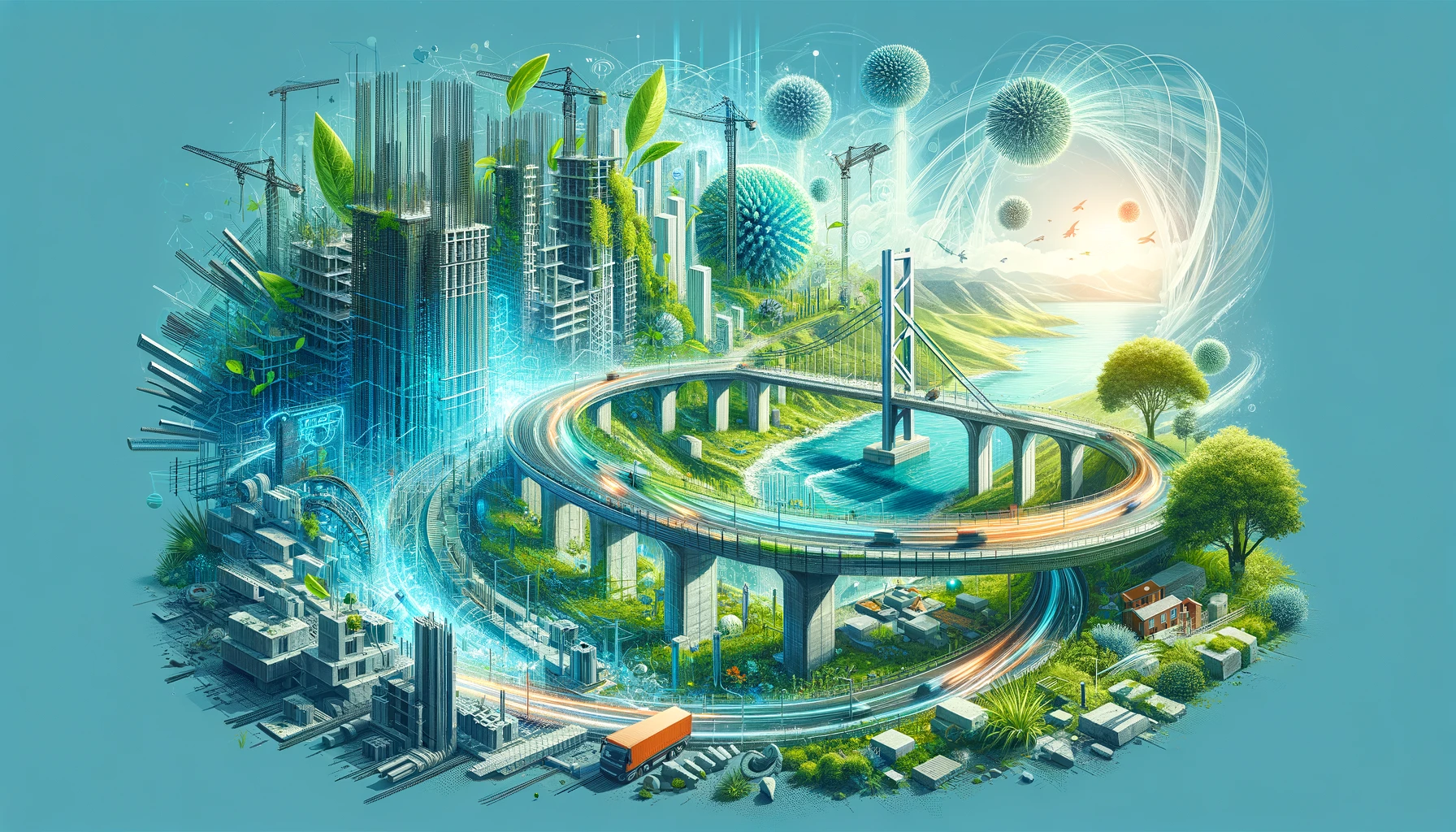TMT rebar is considered eco-friendly due to its recyclability and energy-efficient production process. It supports sustainable construction practices. Additionally, TMT rebar helps reduce the environmental impact of construction by promoting the use of ecofriendly construction materials. Its durability and strength also contribute to the longevity of a building, reducing the need for frequent renovations and resource consumption. Overall, TMT rebar plays a crucial role in promoting environmentally conscious construction practices.
Thermo-Mechanically Treated (TMT) rebar stands as a champion in the construction industry for its environmental credentials. Builders and architects often prioritize TMT rebar for its durability and strength, which directly contribute to the longevity of structures. This means fewer resources are consumed over time for repairs or rebuilding.
TMT rebar’s manufacturing process is designed to minimize waste, and the product itself can be recycled at the end of its lifecycle, further reducing its environmental footprint. These qualities make it an attractive option for projects aiming to meet green building standards. As the industry moves towards more sustainable practices, TMT rebar is becoming increasingly popular, embodying the principles of eco-friendliness and resource efficiency.
Introduction To Tmt Rebar
TMT Rebar, short for Thermo-Mechanically Treated Rebar, is a modern construction marvel. It’s stronger and more flexible than old rebar. Builders love it for its durability. It also helps in making eco-friendly buildings. Let’s explore how TMT is changing construction.
The Rise Of Tmt In Construction
TMT Rebar has gained popularity for good reasons. Its making process is special. This process gives it high strength. It also makes buildings safer. Earthquake areas benefit a lot from TMT Rebar. Here’s why many choose TMT over old options:
- High strength: Buildings stand tall and strong.
- Flexibility: It bends without breaking. This is good for safety.
- Corrosion resistance: It lasts longer, even in wet places.
Comparing TMT To Traditional Rebar Materials
Difference between TMT and old rebar is clear. TMT offers benefits that old rebar can’t match. Here’s a quick comparison:
| Feature | TMT Rebar | Traditional Rebar |
|---|---|---|
| Strength | High | Lower |
| Flexibility | Yes | No |
| Corrosion Resistance | Good | Poor |
| Eco-Friendly | Yes | No |
TMT Rebar stands out for its eco-friendly nature. It uses less energy in making. It also reduces waste. This makes it a green choice for construction. It’s clear why TMT is the future of building materials.
Manufacturing Process Of TMT Rebar
The manufacturing process of TMT Rebar is crucial to its sustainability. It involves complex steps that transform raw materials into the robust bars used in construction. Let’s delve into the specifics of these procedures and their environmental implications.
Key Steps In Producing TMT
- Extraction: It starts with mining iron ore.
- Refining: Ore turns into molten iron.
- Shaping: Molten iron forms into steel billets.
- Rolling: Billets pass through rolling mills.
- Quenching: Water cools the outer layer quickly.
- Tempering: The core cools at a slower rate.
- Cutting: Bars are cut to required lengths.
Energy Consumption And Its Implications
Energy use in TMT Rebar production is high. This affects our planet. Here’s how:
| Process | Energy Used | Impact |
|---|---|---|
| Refining | High | CO2 emissions increase |
| Rolling | Medium | Electricity demand rises |
| Quenching | Low | Water usage is significant |
Each step uses resources and energy. This affects air and water quality. Companies aim to reduce these impacts. They use renewable energy and recycle water.
TMT Rebar And Its Environmental Impact
Understanding the ecological effects of construction materials is crucial. TMT rebar, a popular choice for building, has impacts worth noting. Let’s examine its carbon footprint and waste generation.
Carbon Footprint Analysis
Steel production emits significant CO2. TMT rebar’s manufacturing involves intense energy use. Energy mostly comes from fossil fuels. This releases greenhouse gases. It affects climate change.
- High energy use during smelting
- CO2 emissions from fossil fuels
Recent innovations aim to reduce this impact. They include:
- Energy-efficient furnaces
- Recycling scrap metal
Waste Generation During Production
Steel making generates waste. TMT rebar production is no exception. Waste includes slag, dust, and other by-products. Proper waste management is key.
| Waste Type | Handling Method |
|---|---|
| Slag | Recycling into construction |
| Dust | Collection and disposal |
Firms are now focusing on:
- Reducing waste generation
- Improving recycling methods
Eco-friendly practices help. They make TMT rebar a greener option.
Recyclability Of TMT Rebar
The ‘Recyclability of TMT Rebar’ is crucial in today’s eco-conscious world. TMT, short for Thermo Mechanically Treated, is often used in construction. Its eco-friendliness lies in its ability to be recycled. Let’s delve into the life cycle of TMT materials and the challenges faced during recycling.
Life Cycle Of TMT Materials
TMT rebar goes through many stages. It starts as iron ore, transforms in a steel mill, and ends as construction support. At each stage, energy and resources are used. The key is that TMT can come back as new rebar. This makes TMT an eco-friendly choice for building.
Challenges In Rebar Recycling
- Separation: Mixed materials can make it hard to recycle TMT rebar.
- Contamination: Rust and dirt can affect the quality of recycled TMT.
- Collection: Gathering scrap TMT rebar is labor-intensive.
- Processing: Rebar needs cutting and reshaping for recycling.
Despite these challenges, TMT rebar remains a top eco-friendly choice. It can be melted and reused, reducing waste. As technology advances, recycling TMT rebar will likely become easier, making it a key player in sustainable building.
TMT Rebar In Sustainable Building Practices
Thermo Mechanically Treated (TMT) rebar is a modern solution for stronger structures. It is also known for its eco-friendly properties. Builders use TMT rebar to create sustainable projects. These rebars support green construction goals.
Role In Green Construction
TMT rebar plays a key role in eco-friendly building. It is highly durable and recyclable. This makes TMT rebar a favorite in green construction projects. TMT rebar reduces the environmental impact of buildings.
- High strength allows for less material use
- Corrosion resistance extends the life of structures
- Recyclability ensures materials don’t go to waste
Case Studies Of Eco-friendly Projects
Many successful projects have used TMT rebar. These projects show how TMT rebar helps the environment.
| Project Name | Location | Features |
|---|---|---|
| Eco Tower | New York | Uses TMT rebar for reduced carbon footprint |
| Green Heights | London | TMT rebar for longevity and less waste |
| Solaris Complex | Tokyo | Incorporates TMT rebar in solar-powered design |
These projects showcase TMT rebar’s eco-friendly benefits. Each project contributes to a greener planet.

Credit: www.getfibar.com
Regulations And Standards For Eco-friendly Construction Materials
Understanding Regulations and Standards for Eco-Friendly Construction Materials is key. These rules ensure buildings are safe and green. They affect how materials are made, used, and disposed of.
International Guidelines For Sustainable Materials
Global bodies set these rules. They aim to protect our planet. Countries use these guidelines to make their own rules.
- ISO 14000 – Focuses on environmental management.
- LEED – Measures building sustainability.
- BREEAM – Assesses building projects for their green impact.
These standards help countries and companies build greener projects.
TMT Rebar Compliance
TMT Rebar, or Thermo Mechanically Treated Rebar, is a popular choice for construction. It’s known for its strength and flexibility. But, is it green?
To be eco-friendly, TMT rebar must meet certain criteria:
- Low carbon footprint in production.
- Efficient use of resources in manufacturing.
- Recyclability at the end of life.
Many TMT rebar producers are working hard to meet these standards. They use green technology and recycle materials. This makes TMT rebar a good choice for green building.
Innovations In TMT Rebar Technology
The construction industry seeks stronger, more durable materials. TMT (Thermo-Mechanically Treated) rebars are at the forefront. Innovations in TMT rebar technology are crucial. They make construction eco-friendlier.
Advancements For Reduced Environmental Impact
New methods in TMT rebar production are changing the game. These methods cut down emissions. They reduce water use. They improve energy efficiency. The goal is to minimize harm to the environment.
- Recycled materials: TMT rebars now incorporate recycled steel. This reduces waste.
- Energy-efficient furnaces: These furnaces lower carbon footprint. They save energy.
- Water conservation: Closed-loop water systems are in use. They recycle water in the cooling process.
Future Of Eco-friendly TMT Production
Research is paving the way for greener TMT rebar production. The industry is moving towards sustainability.
| Technology | Benefit |
|---|---|
| Carbon capture | Reduces greenhouse gases |
| Electric arc furnaces | Uses renewable energy |
| Automation | Enhances efficiency, cuts waste |
These technologies promise a cleaner future. They show commitment to our planet’s health. Expect more eco-friendly TMT rebars soon.
Consumer Awareness And Market Trends
As eco-consciousness rises, consumers demand greener products. This includes construction materials. Market trends now lean towards sustainable solutions. TMT rebar is no exception. Let’s explore how this affects demand and industry impact.
Demand For Sustainable Construction Materials
Builders and architects now prefer eco-friendly materials. TMT rebar is under scrutiny. People want to know if it’s green. Eco-friendly materials reduce carbon footprints. They also minimize environmental harm. This shift shapes the rebar market.
- Green buildings are gaining traction
- Regulations push for sustainable materials
- Consumers choose responsibility over cost
Impact On TMT Rebar Industry
The TMT rebar industry feels this eco-push. Manufacturers must adapt or fall behind. Green practices are now critical for success. This includes using recycled materials. It also means less energy use in production. These changes secure a place in the future market.
| Old Practices | New Eco-Friendly Measures |
|---|---|
| High energy consumption | Energy-efficient processes |
| Use of virgin materials | Recycling scrap metal |
| Waste-heavy production | Waste management systems |

Credit: medium.com
Frequently Asked Questions
Is Rebar Environmentally Friendly?
Rebar, typically made from steel, is partially environmentally friendly due to its recyclability. Its production, however, often involves significant energy use and emissions.
What Are The Disadvantages Of TMT?
TMT bars can be costly compared to other reinforcement materials. They may also require specialized handling and installation techniques. Over time, exposure to extreme conditions can lead to corrosion, affecting durability. Lastly, the high strength of TMT bars might complicate welding and cutting processes.
What Is The Most Eco-Friendly Steel?
The most eco-friendly steel is typically recycled steel, as it reduces the need for raw materials and energy consumption.
Are TMT Bars Corrosion Resistant?
Yes, TMT bars are designed to be corrosion-resistant due to their special manufacturing process, which provides them with a protective outer layer.
Conclusion
Exploring the eco-friendliness of TMT rebar reveals a promising path toward sustainable construction. This material not only supports durable structures but also aligns with green building principles. Embracing TMT rebar could significantly reduce environmental footprints, making it a wise choice for eco-conscious projects.
Let’s prioritize sustainability by integrating TMT rebar in our future builds.





















